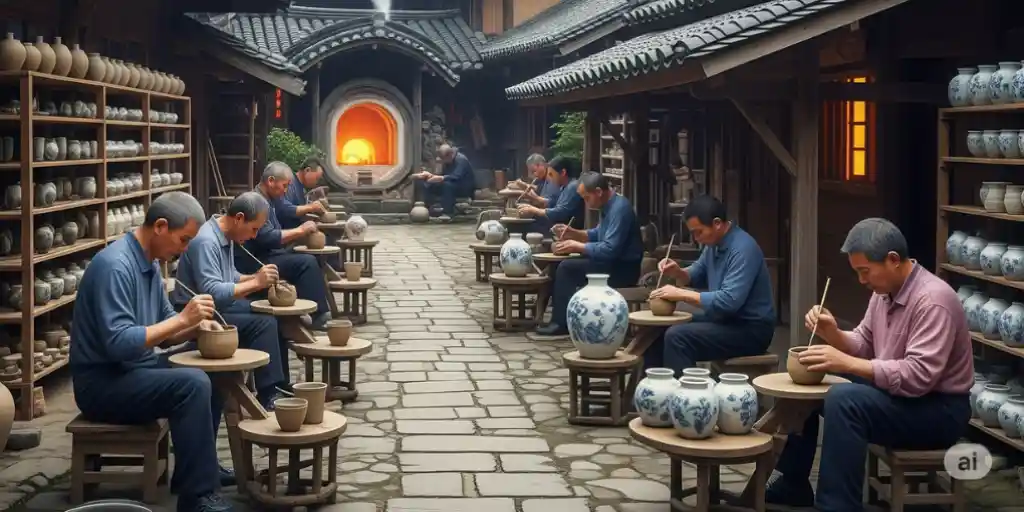In hidden valleys, misty mountains, and along forgotten rivers, ancient ceramic villages still craft pottery as they did centuries ago—by hand, with fire, earth, and soul. These villages are the living museums of Asia's vanishing ceramic traditions, surviving industrialization with art passed down through generations.
In this blog, we’ll explore the last known villages where pottery is still sacred, share why they matter, and offer practical tips for visiting and supporting these timeless communities. Whether you’re a cultural traveler, ceramic lover, or history explorer—this journey goes deep into the kiln-fired heart of Asia.
🔍 What Are Ceramic Villages?
Ceramic villages are rural communities dedicated almost entirely to pottery-making, where:
-
Clay is sourced, shaped, and fired locally
-
Techniques date back centuries—often unchanged
-
Artisans live and work in the same space
-
Pottery is used for both ritual and daily life
They preserve heritage far beyond the pottery itself.
💡 Why Are These Villages Disappearing?
These traditions are fading due to:
-
Mass production and factory imports
-
Younger generations migrating to cities
-
Loss of traditional clay sources and wood kilns
-
Lack of global recognition or economic support
So yes—these are the last flames of an ancient craft.
✈️ Famous Yet Fading Ceramic Villages Across Asia
| Country/Region | Village Name | Specialty Pottery Style |
| Japan (Okayama) | Bizen | Unglazed wood-fired pottery |
| China (Jiangxi) | Jingdezhen villages | Porcelain-making since 1000 AD |
| Vietnam (Hanoi outskirts) | Bat Trang | Hand-painted ceramics & temple wares |
| India (Kutch, Gujarat) | Khavda Village | Terracotta with geometric painting |
| Thailand (Chiang Mai) | San Kamphaeng | Celadon-glazed green pottery |
🛡️ Top Tricks to Visit Ceramic Villages Respectfully
Let’s look at the most ethical and engaging ways to explore these fragile art centers without turning them into tourist traps.
1. ✅ Buy Directly From the Artisan’s Home
Why it matters: Souvenir shops often underpay or fake the work.
Ceramic Hack:
-
Visit working homes or workshops instead of stores.
-
Pay fair value—don’t haggle hard for handmade heritage.
2. 🧱 Join a Pottery Class in the Village
The trap: Watching is passive—doing builds appreciation.
Why it’s powerful:
-
Even a one-hour session gives deep respect for the craft.
Cultural Tip:
-
Many villages offer classes with masters—ask your local guide or homestay host.
-
You may even get to fire your own cup or plate.
3. 🛕 Understand the Spiritual Role of Pottery
Problem: Pottery isn’t just functional—it’s sacred.
Why it’s cultural:
-
In many Asian traditions, clay holds memory, earth energy, and purity.
Ceramic Culture Hack:
-
Ask about ceremonial use—many pots are linked to festivals, offerings, or ancestor rites.
-
Don't touch unfinished pots without permission.
4. 🧭 Visit During Local Pottery Festivals
Why it matters: These are the best times to see the full culture alive.
Travel Tip:
-
Bizen Pottery Festival (Japan), Bat Trang Pottery Fair (Vietnam), and Terracotta Utsav (India) are top events.
-
You’ll see live demos, kiln firings, and traditional dances.
5. 🧳 Pack Light, Ship Heavy
Problem: Ceramics are fragile and heavy to carry.
Why it’s smart:
-
Villages often help ship goods internationally.
Packing Trick:
-
Buy what you love and ship with tracking—supports economy without damaging your luggage.
💳 Best Platforms to Find Ceramic Villages in 2025
| Platform/Tool | Use Case | Bonus Feature |
| Atlas Obscura | Discover offbeat cultural sites | Many hidden artisan villages listed |
| Intangible Cultural Heritage (UNESCO) | Global artisan preservation map | Lists endangered craft villages |
| Google Arts & Culture | Explore ceramic heritage virtually | High-res art images + village stories |
| Airbnb Experiences | Local classes hosted by potters | Book classes and studio visits online |
| Local Tourism Offices | Regional travel suggestions | Real-time festival/event info |
🔍 Real User Example
“In Khavda, I stayed in a potter’s home and learned how they mix camel dung with clay. Each pot told a story. I brought back two and now drink chai with heritage in my hand.” – Neha, Slow Traveler
🧠 Pro Tips to Remember
-
Always ask before photographing artisans or altars
-
Buy direct, not from resellers if possible
-
Don’t compare handmade prices with factory items
-
Support the community with more than purchases—stay, eat, engage
-
Look beyond aesthetics—ask about meaning and legacy
💬 Final Thoughts: From Clay to Culture
Ceramic villages are not just about pots—they’re about people, memory, and earth. Visiting them is more than travel—it’s preservation.
✅ Don’t just shop—honor the craft.
✅ Don’t just visit—witness a legacy.
✅ Don’t just admire—engage with intention.
Every handmade vessel carries a story. Will you carry it forward?
📌 FAQs About Visiting Ceramic Villages
Q1. Are these villages safe for solo travelers?
Yes. Most are welcoming and offer homestays. Just check access and transport.
Q2. Is it okay to bargain?
Lightly—but respect the labor. Handmade pottery takes days or weeks to complete.
Q3. Can I take pottery back on a plane?
Yes—but pack carefully or use local shipping options.
Q4. What makes handmade pottery special?
Each piece holds a maker’s touch, regional style, and cultural meaning. It’s functional art with soul.
